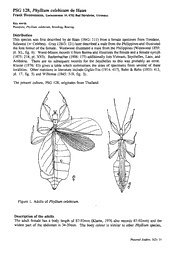
PSG 128, Phyllium celebicum de Haan PDF
Preview PSG 128, Phyllium celebicum de Haan
PSG 128, Phyllium celebicum de Haan Frank Hennemann, Gartenstrasse 14, 6702 Bad Durkbeim, Germany. Key words Phasmida, Phyllium celebicum^ Breeding, Rearing. Distribution This species was first described by de Haan (1842: 111) from a female specimen from Tondano, Sulawesi (= Celebes). Gray (1843: 121) later described a male from the Philippinesand illustrated the fore femur of the female. Westwood illustrated a male from the Philippines (Westwood 1859: pi. XL, fig. 6). Wood-Mason records it from Burma and illustrates the female and a female nymph (1875: 218, pi. XVI). Redtenbacher (1906: 175) additionally lists Vietnam, Seychelles, Laos, and Amboina. There are no subsequent records for the Seychelles so this was probably an error, Klante (1976: 63) gives a table which summarises the sizes of specimens from several of these & localities. Other mentions in literature include Giglio-Tos (1914: 417), Rehn Rehn (1933: 413, pi. 17, fig, 5) and Willemse (1945; 319, fig. 3). The present culture, PSG 128, originates from Thailand. Figure 1. Adults of Phyllium celebicum. Description of the adults The adult female has a body length of 87-92mm (Klante, 1976 also records 87-92mm) and the widest part of the abdomen is 34-39mm. The body colour is similar to other Phyllium species, Phasmid Studies, 1(2): 31 Frank Hennemann light or grass green. This species is easily distinguished from others in the genus. Other Phyllium females have no hind wings but under the elytra of the female of Phyllium celebicum fully developed wings are concealed; these are about 45mm long. The female is unable to fly because the body is too heavy. Only the mid and hind tibiae have no lobes. As in other Phyllium species, the antennae of the female are very short. Sizes (mm) Female Male 1st Instar Body length 87-92 55-60 12-15 Maximum body width 34-39 17-21 - Antennae 2.5-3.0 40 - Fore leg 40 30 - Mid leg 33 25 - Hind leg 40 25 - The adult male has a body length 55-60mm (Klante 1976 records 55-59). The greatest width of the abdomen is 17-21mm, on the third and fourth segments. His body colour is like that of the female, light or grass green. The body is wedge shaped and there are two transparent patches on the fourth abdominal segment. The wings are similar to those ofother Phyllium species; they allow fluttering over short distances. As with the females, only the mid and hind tibiae are the only parts of the legs without lobes. In common with other species in the genus, the antennae of the male are much longer than the female’s. Eggs (fig 2) The eggs are shaped like a small deformed "jerry can" and are 5mm long and 3.5mm wide. The colour is a dull brown. The edges look like they are moss covered and around the capitulum and micropylar plate the egg is covered with some small holes. The micropylar plate is oval with the ends pointed. The capitulum is big and cone shaped. Eggs should be incubated at 24-26°C and high humidity (70- Figure 2. The egg of Phyllium 80%). The best medium is peat. celebicum. Nymphs (fig 3) The newly hatched nymphs are chestnut coloured and have white spots on the body and legs. The body length is 12-15mm on hatching. When they are older they become light green like the adults. In the third instar you can distinguish males and females; females are a bit bigger and have a wider abdomen than males. In the fourth instar you can distinguish the longer antennae of the males. I keep my nymphs in a well ventilated cage at 22-24°C and spray them once or twice per day. Defence Nymphs try to escape by running away, adults do the same. What is not well known, is that Phyllium species possess defence glands like those ofAnisomorpha buprestoides and Oreophoetes Phasmid Studies. 1(2): 32 PSG 128, Phyllium celebicum peruanas. They are situated on both sides of the pronotum and are used against predators like birds and monkeys. Rearing This species seems to be easier to rear than the other Phyllium species which have been in culture for some years in Europe (P, bioculatum, P, giganteum, P, pulchrifolium). Adults and nymphs should be kept warm (22-28°C) and humid (70-80%). The foodplant should be sprayed daily, this is important for the skin Figure 3. The nymph of shedding. In these conditions nymphs take about six months to Phyllium celebicum. become adult. Foodplants Bramble, oak and pyracantha are eaten, nothing else has been tried. References Giglio-Tos, H. (1914) Results of the Arbor Expedition 1911/12. Part V. XXXI Orthoptera, III: Mantidae et Phasmidae. Records ofthe Indian Museum, 8: 415-423. Gray, G.R. (1843) Description ofthe species ofthe genus Phyllium. Zoologist, (1)1: 117-123, Haan, W. de (1842) Bijddragen tot de KennisOrthoptera. in Temrainck, Verhandelingen overde Natuurlijke Geschiedenis der Nederlandsche Overzeesche Bezittingen. Volume 2. Klante, H. (1976) Die "Wandelnden Blatter" Eine taxonomische Revision der Gattung Phyllium 111. (Insecta Orthoptera, Phasmatoptera). Zoologische Beitrdge, 22: 49-76. Redtenbacher, J. (1906) Die Insektenfamilie der Phasmiden. Volume 1. Leipzig. Rehn, J.A.G. & Rehn, J.W.H. (1933) On certain species ofthe genus Phyllium (Orthoptera; Phasmidae). Proceedings of the Academy ofNatural Sciences ofPhiladelphia, 85: 411-427, pi. 16-17. Westwood, J.O. (1859) Catalogue ofOrthopterous insects in the collection ofthe British Museum, Part /, Phasmidae. London. Wood-Mason, J, (1875) On new or little known species ofPhasmidae, with a briefpreliminary notice of the occurrence of a clasping apparatus in the males throughout the family. Journal ofthe Asiatic Society ofBengal. 44: 215-220 pi. XVI & XVII. Willemse, C. (1945) On Phyllium species, known from the Key Islands. (Orthoptera: Phasmidae, Phylliinae). Tijdschrifi voor Entomologie, 88; 316-322. Phastmd Studies, 1(2): 33
